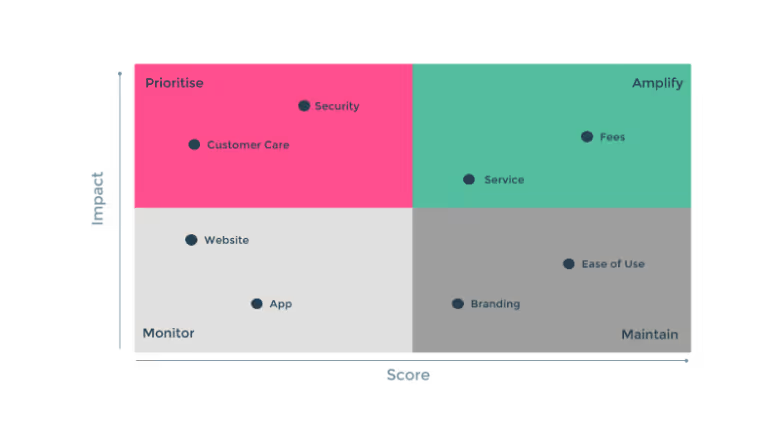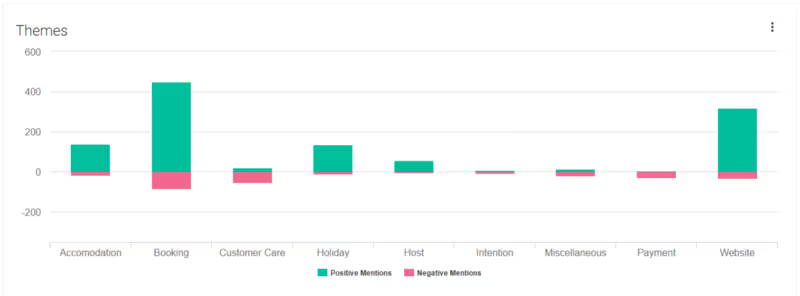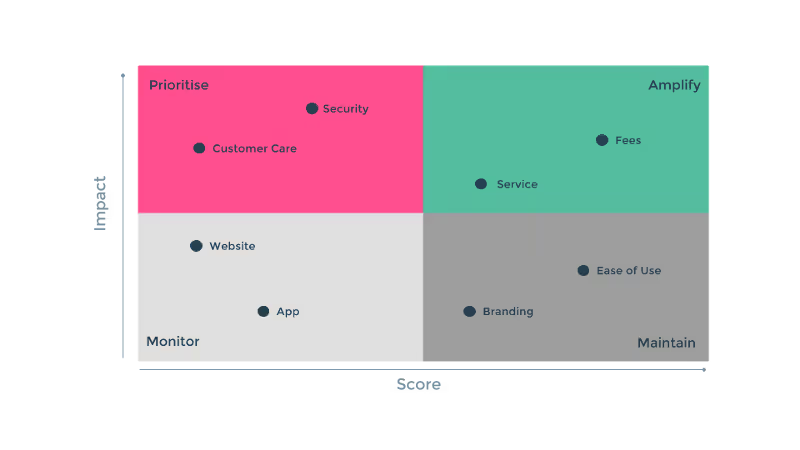
Customer Experience (CX) has become a business cliché. Everybody seems to agree that it is important to have good CX. However very few people can actually articulate exactly what CX is let alone how to measure and improve it over time. Furthermore, return on investment has historically been an awkward topic for CX (and market research in general, to be honest) to the extent that the incentives for improving CX are far from clear.
Yet we see companies such as Airbnb, Slack and Zoom effectively use CX to achieve phenomenal growth.They are not just great companies, that use CX, each of them has specifically mentioned CX time and time again as one of their key growth drivers.
Having seen the potential of CX and at the same time the staggering lack of understanding of it during my time in the market research industry, I was keen to fix this and thus Chattermill was born. We have developed Deep Learning based technology to help companies measure and improve their CX.
This post will show you what CX is actually made up of, how to measure it and how to benefit from it.
So What Is CX?
A good definition of CX is:
Customer Experience is the mix of Utility and Emotional value a company brings to its customers.
CX is not a simple number. It is a chaotic mix of numerous interactions the customer has with your company, both offline and online, before during and after the purchase of the product or service. It can include anything from how well your product or service solves the customer’s problem to how your brand image fits in with their aspirations and social status.
Examples of Utility value:
- Price
- Product availability
- Ease of use
Examples of Emotional value:
- Brand perception
- Advertising
- Customer care
The exact set of values will be unique to each company. It is also important to note that the values can be experienced as positive or negative — they have sentiment. For example, a typical customer care experience could consist of a pleasant time speaking to the friendly representative but frustration while waiting in the phone queue.
CX, Net Promoter Score And Customer Satisfaction
You may be asking how does CX compare to Net Promoter Score (NPS) or Customer Satisfaction (CSAT)? These metrics were designed to be a proxy to CX are a good place to start but have the following limitations:
- No answer to Why? - when looking at the topline NPS or Customer Satisfaction metric, it is impossible to be sure why say 25% of your customers are Detractors or why NPS has gone down by 8 points compared to last month. CX cannot be explained by one number — it is about understanding how the customer feels about the various values you company brings to them.
- Biased sample - more often than not NPS / CSAT data is collected as part of a longer survey that will get at best 5% response rate. The customers who do respond would be either the delighted or the very upset. Also younger people are far less likely to answer long surveys. These sort of sampling issues give you data about the extremes of your CX rather than the “typical scenario” or the view of one demographic but not everybody.
- Lack of continuity - CX is not static, it changes every day. Most companies, however, measure NPS or CSAT via a mass survey once or at best twice a year. This makes it very hard to spot problems quickly. One company we approached experienced this firsthand when a problem with their booking system went unnoticed for almost a year causing hundreds of declined bookings and many thousands of pounds in lost revenue. They did run a survey but it was done by hand and only once a year. If they sent small batches to customers every day they would have spotted the problem much quicker and saved a lot of revenue and frustrated customers.
The above three points about the limitations of NPS and CSAT can be overcome. For example, by collecting and reading customer comments you can understand the context, using short, well designed surveys will yield higher response rates (we typically get at least 25% on our surveys) and automated survey sendout right after a touchpoint will help spot problems in real time.
In reality, however, setting up and maintaining a good survey campaign as well as analysing the data (remember this includes reading all of the comments to understand context) is very hard. Out of over 100 companies we talked to only a handful collected NPS in a way that was helping them understand their CX to a level where they could make informed decisions based on it.
What Does CX Look Like On Paper?
Talking about CX is one thing but actually measuring it is a whole different challenge. Because CX is something experienced by the customer — you can only measure it by asking the customer. We have found that a simple survey that gets the customer to talk about their experience in their own words is the best way to measure CX at scale. You can read more about the survey here but for reference here is what a typical response may look like:
“Moo may be a bit more expensive than other printing companies- but you’re paying for what you get. As an artist, Moo is the best option for me. Printing quality is great and that’s extremely important to me.”
Once you have the data — there are two ways of looking at data like the comment above: at an individual level and at aggregate level.
Individual Level — Understanding And Acting Upon The Experience Of A Particular Customer
Asking a customer for feedback should not be a one way conversation. The leaders in customer experience respond to most of their customer feedback, particularly if it is negative. Responding to feedback has the following advantages:
- Customers who had a negative experience are less likely to do business with you again. Responding to their negative feedback and, if possible, resolving their problem is an opportunity to retain them. Note that not all customers will proactively reach out to the support desk to report a problem. Asking for feedback may be the only way of reaching them.
- Customers who in turn had a positive experience and left positive feedback should be thanked even if it is done via an automated message or landing page after the survey. This is also a great opportunity to engage with the satisfied customer: for example you could ask the customer to like you on Facebook or give them a refer a friend code.
Aggregate Level — Understanding The Overall CX
If you have a customer base size of over 5,000 people — you will get enough data to start analysing trends from the individual comments. To do so — start assigning tags (or what we call Themes) for topics that come up again and again. This way you can effectively see the core elements of your CX that the customer is recalling.
Below is an example of the Themes for the Holiday Booking sector that we gathered through our survey:

You can see the relative frequency with which different components are mentioned when the customer recalls their experience. If you can assign positive as well as negative versions of the same label you can get the sentiment for the different topics that are being talked about. Note that this is not the number of times a particular word or group of words is mentioned. This so called ‘keyword approach’ is misrepresentative for a number of reasons, not least the difficulty in distinguishing negative and positive sentiment but also due to more fundamental biases and limitations of the analysis. For this reason it often leads to an organisation focusing on or prioritising the wrong things or simply making decisions that are contrary to what the data actually supports. This is about understanding what a customer is talking about and their feelings about it regardless of the words / phrasing they use. The solution that worked for us involved Deep Learning — a branch of Artificial Intelligence that teaches machines to understand incredibly complex patterns, which in our case is reading the meaning and sentiment of what is being communicated in free form text, similar to the way that a human would.
Taking the topics analysis further it is possible to dive deeper and see what the above CX components are made of. For example:

With this level of detail our partners get a better understanding how different parts of the business are contributing to the overall CX.
For example one of our e-commerce flower delivery clients has a feature where they send a photo to the customer when the flowers have been delivered to the intended recipient. The original function was simply to provide a visual confirmation of the order however by tracking this theme closely they were able to identify that this feature was one of the most talked about aspects of their service and and a key differentiator from their competitors in terms of why customers would recommend them to their friends.
Prioritising Investment For A Better CX
CX has a significant impact on customer acquisition cost, share of wallet and customer retention. Consequently improving CX will enhance the performance of your business. While this may seem obvious, the problem a lot of businesses face is identifying which element of the customer experience to invest time and money in for maximum return on investment.
It was never clear what exactly you get out of improving the customer experience and therefore which elements of the CX should be improved first. To solve this problem we provide tools to understand which area you should invest in to give the maximum return.
To achieve this, we map out how various elements of CX impact the Net Promoter Score which we know to correlate with Customer Lifetime Value.

In this example the vertical axis is the magnitude of impact on NPS i.e. how important that element is to shaping the overall experience. The horizontal axis is the sentiment — that is the elements that get mentioned in a negative context float to the left, and positive elements shift to the right.
Items in the top right corner are important to the customer and as a company you are are performing well and you should look to amplify these. Conversely they are also the areas where you are most vulnerable to a competitor if they were to effectively match you on these elements.
In contrast items in the top-left corner are important to the customer but the feedback has been mostly negative. These are the areas to prioritise for improvement as it is likely they are hurting your bottom line. Looking at the CX data in this way helps organisations we work with prioritise investment.
What Does This All Mean
Customer experience is rapidly becoming the primary battleground for companies looking to outperform the competition. Companies with a good customer experience benefit from reduced customer churn and lower acquisition costs for new customers. Perhaps less obviously they also often have happier employees simply because people enjoy working for likeable companies that bring positive value, whether Utility or Emotional, to its customers.
To improve customer experience it needs to be measured first. Established survey techniques such as Net Promoter Score and Customer Satisfaction can be used to measure and understand customer experience if done in the right way. This does however come with labour intensive challenges such as analysing the free form comments by topic and sentiment on an ongoing basis.
At Chattermill we help you collect high quality feedback from your customers and we then help you make sense of it all by applying Artificial Intelligence.














